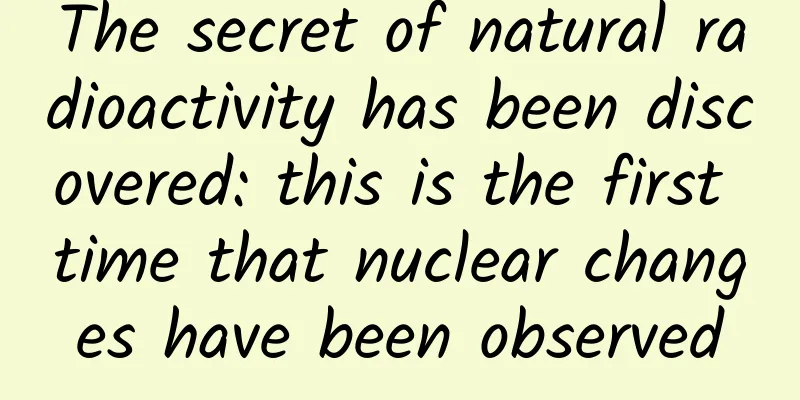The secret of natural radioactivity has been discovered: this is the first time that nuclear changes have been observed

|
On February 21, 1896, French physicist Henri Becquerel announced at the French Academy of Sciences that uranium salts, when exposed to sunlight, could emit a type of X-ray similar to that of X-rays, which could pass through black paper, glass and other materials to make the film sensitive to light. At first, he mistakenly believed that this type of ray was the result of sunlight. On March 2 of the same year, he unexpectedly discovered that this type of ray had nothing to do with sunlight. He then discovered the radioactivity of elements through observations of various uranium salts. French physicist Henri Becquerel In 1903, half of the Nobel Prize in Physics was awarded to French physicist Henri Becquerel in recognition of his discovery of spontaneous radioactivity; the other half was awarded to French physicists Pierre Curie and Marie Sklodowska-Curie in recognition of their outstanding contributions to the radiation phenomenon discovered by Becquerel. Becquerel doing his experiment Lays the foundation for the birth of nuclear physics French physicist Henri Becquerel was an expert in fluorescence and phosphorescence. In early 1896, the news that German physicist Wilhelm Conrad Roentgen had discovered X-rays reached Paris, and by chance he encountered the problem of radioactivity. At that time, there was a famous mathematical physicist in France named Henri Poincare. After receiving Roentgen's communication, he reported the matter to the participants at the regular meeting of the French Academy of Sciences on January 20, 1896, and showed Roentgen's communication and X-ray photos. Becquerel happened to be present, and he asked Poincare how this ray was produced? Poincare replied that it seemed to be produced from the fluorescent place opposite the cathode of the vacuum tube, which might be the same mechanism as fluorescence. Poincare also suggested that Becquerel try whether fluorescence would be accompanied by X-rays. So the next day, Becquerel began to experiment in his laboratory whether fluorescent substances would radiate invisible rays that could penetrate thick paper and make the film sensitive to light. He tried again and again and finally found a substance that had the expected effect, which was uranium salt. Becquerel took two pieces of thick black paper and wrapped the photographic film so tightly that even if it was left in the sun for a day, it would not be sensitive to light. Then he put uranium salt on the film wrapped in black paper and exposed it to the sun for a few hours. The difference was huge, and the film showed a black shadow. In order to prove that it was the rays that were at work, he deliberately placed a layer of glass between the black paper package and the uranium salt, and then placed it in the sun. If it was due to some chemical reaction or thermal effect, the layer of glass should have ruled it out, but the black shadow still appeared. So Becquerel confirmed Poincare's hypothesis and reported the experimental results at the regular meeting of the French Academy of Sciences. Becquerel's photo verifying natural radioactivity A few days later, Becquerel was preparing to further explore this new phenomenon, but Paris was cloudy for several days and there was no sun exposure. He had to put all the equipment, including the wrapped film and uranium salt, in the same drawer. Perhaps out of some professional inspiration, Becquerel suddenly had an idea to see if the film would turn black even without sun exposure. So he developed the film. Who would have thought that the black shadows on the film were really obvious. He carefully examined the scene and was sure that these black shadows were the result of the action of uranium salts. Faced with this sudden phenomenon, Becquerel quickly realized that he had to abandon his original hypothesis. This kind of radiation had no direct relationship with fluorescence. Unlike fluorescence, it did not require external light excitation. He continued to experiment and finally confirmed that this was a kind of radiation emitted by the uranium element itself. He called this kind of radiation uranium radiation. Uranium radiation is different from X-rays. Although both have strong penetrating power, their generation mechanisms are different. The terrifying uranium ore In May of the same year, he reported to the French Academy of Sciences that uranium radiation is a function of the atom itself. As long as the element uranium exists, this radiation will continue to be generated. This is the initial process of discovering radioactivity. Although this discovery did not cause as much of a sensation as Roentgen's discovery of X-rays, its significance is still far-reaching, laying the first cornerstone for the birth of nuclear physics. The Curies' Experiment Becquerel's paper on the discovery of radioactivity aroused great interest of the Curies. In 1897, according to Pierre Curie's suggestion, Marie Curie chose radioactivity as her doctoral thesis. At first, she just repeated Becquerel's uranium salt radiation experiment, but because she made significant improvements in the measurement method, she not only obtained qualitative results, but also obtained a large amount of accurate data. She used the quartz crystal piezoelectric balance invented by the Curie brothers to replace Becquerel's electroscope. Madame Curie first verified Becquerel's conclusion and confirmed that the intensity of the new radiation was only proportional to the uranium content in the compound, had nothing to do with the composition of the compound, and was not affected by factors such as light, heating, and electricity. She confirmed that this was an atomic process. Becquerel and Marie Curie But she was not satisfied with this conclusion and decided to conduct a comprehensive examination of all known elements. She found various ores and chemicals and conducted experiments one by one. The preliminary results obtained in 1898 showed that the ionization current of most materials was relatively small, but pitchblende, thorium oxide and chalcocite (containing uranium phosphate) produced very strong ionization currents. Therefore, Madame Curie concluded that thorium was also a radioactive element. She also found that pitchblende and chalcocite were much more active than pure uranium. Madame Curie thought that since both uranium ores were more active than uranium itself, it was believed that these ores might contain elements that were much more active than uranium. Marie Curie believed that since more than one element could spontaneously emit radiation, it was obviously a common natural phenomenon. The discovery of radium After that, the Curies discovered through chemical analysis and physical instrument testing that the composition of bismuth showed strong radioactivity, 400 times stronger than the same mass of uranium. They further confirmed that the radioactivity did not come from the bismuth itself, but from a trace element mixed in the bismuth. After repeated experiments, they found that they could use the different solubility characteristics of the two metals to separate them. After adding water to dissolve the bismuth salt, they found a particularly strong radioactive substance from the slag that precipitated first. The Curies suggested calling it polonium. Then, the Curies continued their separation experiments and found that barium salts had stronger radioactivity. They believed that there was a second substance with stronger radioactivity and completely different chemical properties from the first one. It could not be precipitated by hydrogen sulfide, ammonium sulfide or ammonia. This new radioactive substance was completely like pure barium in chemical properties. Its chloride was soluble in water but not in concentrated hydrochloric acid and alcohol. The spectrum of barium could be obtained from it. They believed that there must be a new element in this substance with chemical properties extremely close to barium but capable of producing very strong radioactivity. They carried out a series of separations and obtained increasingly active chlorides, which were more than 900 times more active than uranium. They named this new radioactive element radium. In 1902, the Curies announced that they had measured the atomic weight of radium to be 225 and found two very bright characteristic spectral lines. Only then was the existence of radium recognized. Madame Curie later suffered from pernicious anemia for a long time. She and Mr. Curie must have been exposed to large doses of radiation at work, and may have even eaten a lot of radioactive substances. The cookbook she used at the time was still radioactive when checked 50 years later. Madame Curie died in 1934 after suffering from long-term anemia. Her daughter Irene and son-in-law Frederic Joliot also died of pernicious anemia in 1956 and 1958 respectively. The Curies contributed radium to mankind, but they themselves lost their precious lives to radium. |
>>: Pluto: No Longer a Planet Controversy
Recommend
Tik Tok’s content flow and algorithm logic
In the past two years, Tik Tok , as a national-le...
It’s so fast that even Nezha can’t catch up. Why is the cheetah so fast?
Review expert: Wang Lei, National Park and Nature...
Why do chubby bees make their nests in the shape of a regular hexagon?
Produced by: Science Popularization China Author:...
22 Lectures of Go Language Evangelist's Getting Started Notes
Go has become the most competitive programming la...
How to promote overseas influencers? Overseas influencer promotion tips!
Recently, a screenshot has been widely circulated...
Only 3 steps to complete practical and effective competitive product analysis
This article mainly goes over with you how to eff...
Don't be fooled! There are many "goofs" in space science fiction movies and TV shows
Recently, an Italian female astronaut released a ...
What is the price for Weifang Lighting Mini Program investment? Weifang lamps mini program investment price inquiry
How much is the investment price for Weifang Ligh...
What happened to the 80% drop in real estate transaction volume? What was the real estate transaction volume in February?
Recently, CRIC Research Center released the Febru...
How to create a viral effect to increase conversion rate?
When people are exposed to an explosive amount of...
The cause of the accident was revealed! Why did the subway suddenly break down?
Audit expert: Hu Qizhou Associate Professor, Scho...
91 Ten New Energy Briefs: Tesla's environmental credit sales reached $1.58 billion last year
1. FAW-Volkswagen will purchase new energy credit...
OPPO Pad Air review: A cost-effective beast that emerged amid the trend of large-screen mobile phones and thin and light PCs
In the tablet computer field, whether it is Apple...
The Bronze, Silver and Golden Ages of Chinese Makers
The word "maker" comes from the transla...
iOS 18 upgrade experience, there’s something new!
Yesterday, Apple released the new iOS 18 system, ...









